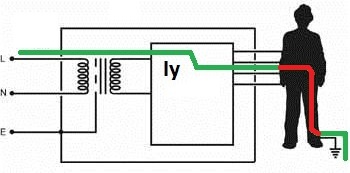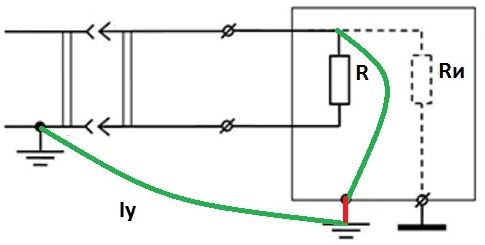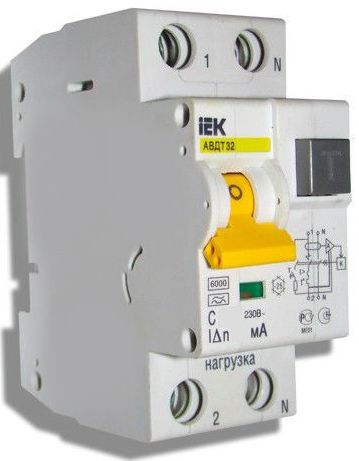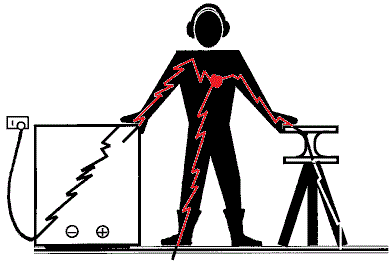Categories: Electrician Secrets, Automata and RCD
Number of views: 92938
Comments on the article: 3
Leakage current in electrical networks, how to check and find leakage current
Leakage current as a physical phenomenon You have probably heard the expression "leakage current" or "leakage current to earth", but can anyone explain what it is? What causes a leakage current, why is it dangerous, how to eliminate it? We will try to get an answer to these questions.

Firstly, for a leak to occur, a current needs a closed electrical circuit, like any conduction current. And practically any conductive object can become a load here: a human body, a bathtub, a pipe, a part of an electrical installation case, etc. And if the leakage current is excessively high, then there may be a danger to human health. That is why it is necessary to have an idea of this phenomenon.

Schematically, the figure shows the path that the leakage current has laid for itself through the human body. Why did the current go through the body in this example? Because the resistance between the housing and the live parts of the installation for some reason decreased. If the unit casing with damaged insulation is grounded, the leakage current will move to the ground, and a fire may occur at the site of contact of the casing with the ground due to heating.

The leakage current to the ground will warm the place of attachment of the ground wire to the housing, this is dangerous by fire. If this happens, for example, at a mining facility, where there is a high probability of abundant release of flammable explosive gases or other flammable substances, this can lead to great tragedy.
For networks with a grounded neutral, the above problem, unfortunately, is typical. But there is another equally dangerous opportunity. Three-phase networks with an isolated neutral are characterized by a leakage of current between the phases along the ground through insulators, a housing, power transmission towers, if the insulation of at least one of the phases is damaged.
The resistance of parallel-connected insulators and supports decreases in proportion to their number, and with damaged insulation step voltage may exceed a value safe for humans. In any case, if the leakage current norm is exceeded, it is urgent to search for the source of the fault and eliminate the leak.
So, the magnitude of the leakage current is associated with the insulation resistance of the conductors, which can be either very large or small when the insulation is broken. One way or another, although very scanty, the real current always flows through any insulation from the live part of the installation, which is currently under voltage, to ground or to another phase.
The safe value of the leakage current is regulated, you can see it in the documentation for the appropriate equipment, but due to the operation of the device in an aggressive environment, the insulation can be damaged and the leakage current will then increase. To protect against unpleasant consequences, it is necessary to use "protective devices against earth leakage currents".

RCD
In order to protect yourself and your loved ones from electric shock and from unnecessary expenses for electric power leaking into the earth, you must use a residual current device or differential circuit breaker (circuit breaker combined with an RCD) - this device will instantly work and will make an emergency disconnection from the network of all consumers in the very beginning of the leak.

About RCD on our website:
How RCD is arranged and works and how to choose it correctly
What are the main types of RCDs and what is their difference
How to connect an RCD and a difavtomat
Earth leakage current at home
Leakage current can create problems in everyday life, some people often use this term, but do they understand the process and are aware of its potential danger? The current is moving phase to earth through conductive objects, such as metal pipes, a washing machine body, a bathtub, a battery - on objects not intended under normal conditions for the passage of current through them.
Aging of the insulation, melted insulation, frequent overloading or mechanically damaged insulation are just a few reasons to think about whether there are leakage currents. Any violation of insulation can lead to leakage of current in the home and to danger to residents. Let's figure out how to protect ourselves from these harmful phenomena in everyday life.
Initially, it must be understood that there is no perfect isolation. Of course, good isolation is not dangerous, but at least a little broken isolation already poses a serious threat. Touching the housing of the washing machine, the cable sheath, or simply the plug, where there is a leakage of current through the damaged insulation, a person can be seriously injured and even die.
A less dangerous, but no less unpleasant symptom of a leak is an increased energy consumption - the current passes through the meter even when the consumers of the apartment or house are completely turned off. We went on vacation, returned, and saw that the refrigerator wound excessively. But the point is not at all in the refrigerator, but in the isolation broken somewhere.

Having an idea of the nature of the leakage current, a person can easily find and eliminate the malfunction, if there is a suspicion. What could be the reason for such a suspicion? For example, touching an electric heater is accompanied by a sensation of a slight electric shock, or touching a washing machine while washing your hands over the bathtub results in a similar sensation. This clearly indicates that somewhere in the device there is a damaged insulation. Need to look for a "leak."
The easiest way to use a multimeter at home or an indicator screwdriver. Or measure resistance with a meggerif such suddenly appeared at hand. Of course, not every inhabitant of the house has a megohmmeter, therefore we will consider the simplest possibilities.
Leak test with indicator screwdriver
Equipment with a conductive shell, such as a refrigerator, a washing machine, a water heater, can be very simply checked for the presence of leakage current with an indicator screwdriver. Carefully touch the case of the switched on device with an indicator screwdriver as if check for phase presence in the outlet. If the indicator lights up at least a little, then this is a clear sign of a leak - you need to look for insulation damage and, no less important, check the connection of the grounding conductor from the outlet to the device body, if such grounding is provided, and generally check the grounding.
Dial tone ohmmeter
Another way to check the integrity of the insulation inside a household appliance is with a multimeter. Unplug the tested household appliance from the outlet, turn on the multimeter in ohmmeter mode, set the measurement limit to 20 megohms. Measure the resistance between the instrument housing and the plug (between the housing and each of the plug pins).
Resistance should be more than 20 megohms - outside the scale. If you have a megohmmeter, then it can be used to similarly measure the insulation state on equipment insensitive to high voltage (the megohmmeter has a high voltage on its probes).
Old way with a radio
A simple household way to find leaks in hidden in the wall wiring. It was always used before before starting repairs, so that workers would not be shocked during plastering. We took a portable radio to medium or long waves, set its reception frequency to a silent station, and with all consumers turned off, walked with the receiver along the wiring path. If the speaker began to make noise, there is a leak at this point.
See also on our website:
Why does an RCD or a difavtomat work in the shield and what to do in this case
What to do if the washing machine is electrocuted
Two phases in an electrical outlet - causes and solution
See also at i.electricianexp.com
:
